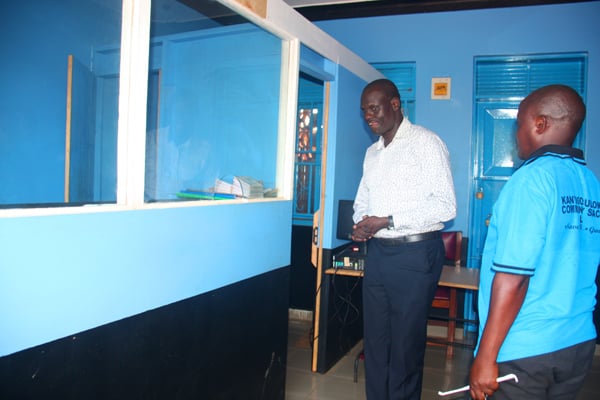
Clients are attended to at the main branch of Nazigo Savings and Credit Cooperative in Kayunga District in June. As of July this year, the Sacco had 10,401 members across its three branches. PHOTO/ABUBAKER LUBOWA
One of the takeaways from David Joseph Schwartz’s book, The Magic of Thinking Big, is that thinking it is possible makes it so. Belief, the book says, allows one to see the routes to success.
That seems to resonate with the thinking of a section of secondary school teachers at St Kalemba Secondary School in Nazigo, Kayunga District, who came together in 2005 to form Nazigo Savings and Credit Cooperative (Sacco).
“The teachers were faced with challenges of self-development. They needed the services of financial institutions, but the nearest banks were in Jinja and Kayunga. The distances were a bit long. So they came up with the idea of forming a Sacco,” Mr Bruno Sserunkuuma, the chairperson of the board of the Sacco, says.
Mr Joseph Mutuyi, one of the founder members, says the teachers used allowances from the Parents and Teachers’ Association (PTA) to pool resources that would in time be used to provide credit for personal development.
“Some contributed Shs20,000 a month, while others contributed Shs50,000. By the end of 2005, we had raised more than Shs1m. That is when we started giving loans,” Mr Mutuyi says.
They registered under the Cooperative Statute of 1991 and the Cooperative Regulations of 1992, and obtained registration licence number 7735 on July 27, 2006.
Beginning small
Initially, the Sacco could not give out big loans because it did not have much in terms of savings and inflows from entrance and paid-up share capital.
“The biggest loan we could provide was Shs300,000, but even then, those would be very few cases. We would mostly give loans of Shs100,000,” Mr Mutuyi says.
Back then, the membership was limited to the teaching staff at St Kalemba Secondary School, but over its 18-year journey, it opened up the doors to the non-teaching staff of St Kalemba first, and later the communities in the eight sub-counties of Kayunga District.
The Sacco had a big number of members in Kayunga, a very vibrant agricultural town, whose people are thriving out of mostly selling produce to Kenyan and Sudanese traders, but they were finding travelling to Nazigo to transact a challenge. A branch was, therefore, opened in Kangulumira.
Another branch was opened up in Kitwe in Baale County. That too serves a community that is thriving out of fishing and sugarcane growing.
Whereas the Sacco acquired the land on which the headquarters and two branches sit, it was with the help of Agricultural Business Initiative (aBi), a social business which funds agribusiness and agriculture in Uganda, that they were completed and equipped. ABi has also helped by way of providing a motorcycle for the Sacco’s field staff. As a result, the value of the Sacco’s total assets stands at Shs2.99b.
Huge savings
As of July this year, the Sacco had 10,401 members across the three branches. The numbers have helped it to grow its share capital, savings and loan portfolios.
“Our paid up share capital stands at 501 million and members’ savings stand at Shs1.740b. The total loan portfolio stands at Shs1.88b,” says Mr Sserunkuuma.
Each share costs Shs10,000, but members are encouraged to buy as many shares as possible. This is not only because the big shares mean bigger dividends at the end of year, but it has a bearing on who physically attends the Annual General Meetings (AGMs). Given the big number of members, the members passed a resolution that only delegates could attend an AGM. One only qualifies to be a delegate to the AGM if they own at least 20 shares.
Mr Sserunkuuma says the Microfinance Support Centre (MSC) has been an integral part of the Sacco’s journey.
“The initial support was from the MSC. It supported us with building capacity and with record keeping and accounting. They also helped us to computerise our systems. Initially, it was manual,” he says.
Mr Peter Mujuni, the MSC executive director, says Nazigo Sacco stands out as a model.
“It is a model from which other Saccos can learn. Its books of accounts are in order, it has skilled professional members of staff, it has a clear and definitive leadership, including an executive board and subsidiary board committees, and it holds AGMs. Those are standards that should be emulated by others.”
Mr Sserunkuuma is quick to point out that not much would have been achieved without the input of MSC.
“Peoples’ savings are a little bit slippery. You cannot loan all of them out because you never know when they will want them. So when there is big demand for loans we go to our partner, MSC. They always provide us with some money for onward lending to our clients.”
Impacting lives
Mr Sserunkuuma blows his own trumpet when it comes to elucidating the manner in which the Sacco has impacted the lives of some of the people here.
“We have touched lives. Some farmers have been transformed through. They have success stories to tell. They have, in their humble way, been able to develop. Some have new buildings, others have been able to pay school fees and their standards of living have improved,” he says.
The impact of the Sacco can be seen mostly in the funding of agricultural activities.
Mr Ibrahim Muyomba, who has been one of the Sacco’s clients since 2011, runs a coffee hurler, a rice mill and a maize mill. The three items are supplied by farmers, most of them either contracted to him or bound to supply him, thanks to his connections with the Sacco.
“When a farmer takes out a loan to grow rice, he is encouraged to sell it to me. I pay the farmer at a price agreed to by both him and the Sacco and pass on the rest of the money to the Sacco, but I make some profit too,” he says.
Most of the rice and maize flour from his mills is sold to schools within the Nazigo area. The coffee beans from his hurling operations are sold to licensed coffee exporters based in the capital Kampala.
“This Sacco has grown me,” Mr Muyomba says.
Siruyi Abdu Mafabi has, with funding from the Sacco, gone into farming coffee, passion fruits, vanilla and vegetables, operations he is conducting on a three-acre piece of land in Kitambuza Village, Kigayaza Parish in Kangulumira Sub-county. He expects to earn at least Shs1m from the sale of vanilla and another Shs3m from the sale of coffee, passion fruits and vegetables. And that was projected income for the first season of the year.
“The loans helped me to establish those gardens. All my help has come from Nazigo Sacco. I take a lot of pride in their work,” he says.




